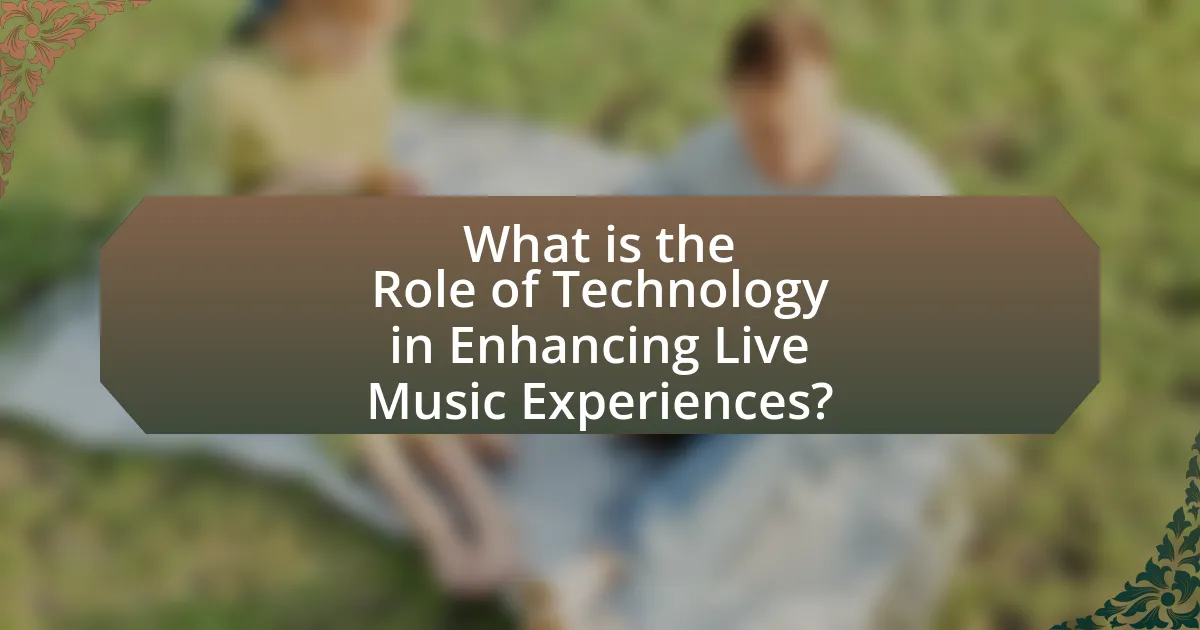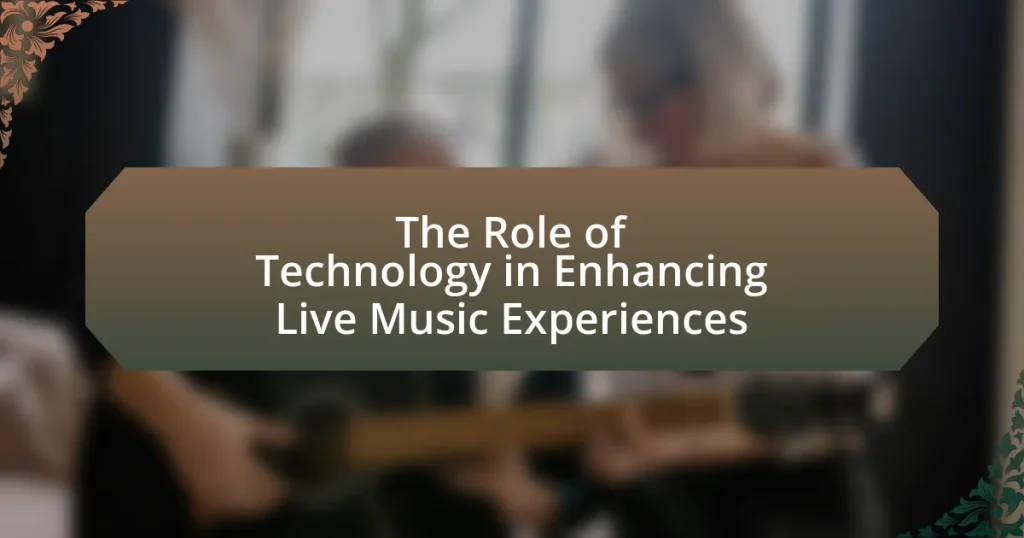The article examines the critical role of technology in enhancing live music experiences, highlighting advancements such as digital sound mixing, augmented reality, and live streaming. It discusses how these technologies improve sound quality, audience engagement, and artist-fan interactions, ultimately transforming the live music industry. Key insights include the impact of social media on event promotion, the challenges faced without technology, and the implications for ticket sales. The article emphasizes that modern live performances rely heavily on technological innovations to create immersive and memorable experiences for audiences.

What is the Role of Technology in Enhancing Live Music Experiences?
Technology plays a crucial role in enhancing live music experiences by improving sound quality, facilitating audience engagement, and enabling innovative performance techniques. Advanced sound systems, such as line array speakers and digital mixing consoles, ensure clear and immersive audio for attendees. Additionally, technologies like augmented reality (AR) and virtual reality (VR) create interactive environments, allowing fans to experience performances in unique ways. For instance, the use of mobile apps for real-time feedback and social media integration fosters a sense of community among concert-goers. According to a 2020 report by the International Music Summit, 70% of festival organizers are investing in technology to enhance audience experiences, demonstrating its significant impact on the live music industry.
How has technology transformed the live music industry?
Technology has transformed the live music industry by enhancing production quality, expanding audience reach, and improving artist-fan interactions. Advanced sound systems and lighting technologies have elevated the auditory and visual experience at concerts, making performances more immersive. Streaming platforms and social media have allowed artists to reach global audiences, with platforms like YouTube and Instagram enabling live broadcasts and real-time engagement with fans. Additionally, ticketing technologies, such as mobile apps and blockchain, have streamlined the purchasing process and reduced fraud, ensuring a smoother experience for attendees. According to a report by PwC, the global live music market is projected to grow significantly, driven by these technological advancements, highlighting their impact on the industry’s evolution.
What are the key technological advancements impacting live music?
Key technological advancements impacting live music include digital sound mixing, live streaming, and augmented reality (AR). Digital sound mixing allows for precise control over audio quality, enhancing the overall experience for both performers and audiences. Live streaming technology has expanded access to concerts, enabling fans to experience performances remotely, which became particularly significant during the COVID-19 pandemic when in-person events were limited. Augmented reality enhances live performances by integrating digital elements into the physical environment, creating immersive experiences that engage audiences in new ways. These advancements collectively transform how live music is produced, consumed, and experienced.
How do these advancements improve audience engagement?
Advancements in technology improve audience engagement by enabling interactive experiences and personalized content delivery. For instance, augmented reality (AR) applications allow concert-goers to access additional information about performances and artists in real-time, enhancing their overall experience. Furthermore, live streaming capabilities expand access to performances, allowing audiences who cannot attend in person to engage with the event through social media platforms, which can increase viewer interaction and participation. According to a report by Eventbrite, 70% of attendees feel more connected to an event when they can share their experiences online, demonstrating that these technological advancements significantly enhance audience engagement.
Why is technology essential for modern live music performances?
Technology is essential for modern live music performances because it enhances sound quality, facilitates complex visual effects, and enables real-time audience engagement. Advanced sound systems, such as digital mixing consoles and high-fidelity speakers, ensure that music is delivered with clarity and precision, which is crucial for audience enjoyment. Additionally, technologies like LED screens and projection mapping create immersive visual experiences that complement the music, making performances more engaging. Furthermore, social media and live streaming technologies allow artists to connect with a broader audience, increasing their reach and interaction during performances. These elements collectively demonstrate that technology is integral to creating memorable and impactful live music experiences.
What challenges does the live music industry face without technology?
The live music industry faces significant challenges without technology, including limited audience reach, inefficient ticket sales, and inadequate promotion. Without technology, artists and venues struggle to connect with potential fans, as traditional marketing methods are less effective in a digital age. For instance, the lack of online ticketing systems can lead to lower sales and increased operational costs, as physical sales require more manpower and resources. Additionally, without social media and streaming platforms, promoting events becomes challenging, resulting in reduced visibility and attendance. These factors collectively hinder the growth and sustainability of the live music industry.
How does technology facilitate better sound quality and production?
Technology facilitates better sound quality and production through advanced audio processing tools and high-fidelity equipment. Digital audio workstations (DAWs) allow for precise editing, mixing, and mastering, enhancing clarity and depth in sound. Additionally, innovations like high-resolution audio formats and lossless compression improve the fidelity of recordings, ensuring that the nuances of live performances are captured accurately. The use of microphones with superior sensitivity and frequency response further contributes to capturing a broader range of sound, while digital signal processing (DSP) enables real-time adjustments to equalization and effects, optimizing the listening experience. These technological advancements collectively lead to a more immersive and high-quality sound experience in live music settings.
What are the different types of technology used in live music?
The different types of technology used in live music include sound reinforcement systems, lighting technology, digital audio workstations, and live streaming platforms. Sound reinforcement systems, such as PA systems, amplify the sound for audiences, ensuring clarity and volume. Lighting technology enhances the visual experience, using LED lights and intelligent lighting systems to create dynamic effects. Digital audio workstations allow for real-time mixing and manipulation of sound during performances, providing artists with creative control. Live streaming platforms enable performances to reach global audiences, utilizing high-definition video and audio technology to deliver immersive experiences. These technologies collectively enhance the overall live music experience by improving sound quality, visual impact, and accessibility.
How do sound systems enhance live performances?
Sound systems enhance live performances by amplifying audio, ensuring that sound reaches the audience clearly and evenly. This amplification allows performers to project their music at higher volumes without distortion, creating an immersive experience for attendees. Additionally, advanced sound systems incorporate equalization and mixing technologies that balance frequencies, enhancing the overall sound quality. For instance, a study by the Audio Engineering Society highlights that well-designed sound systems can improve audience engagement and satisfaction by up to 30%, demonstrating their critical role in live music events.
What role do visual technologies play in live music experiences?
Visual technologies significantly enhance live music experiences by creating immersive environments that engage audiences on multiple sensory levels. These technologies, such as LED screens, projection mapping, and synchronized light shows, transform the concert atmosphere, making performances more visually captivating. For instance, a study by the University of Southern California found that concerts utilizing advanced visual effects can increase audience retention and emotional engagement by up to 30%. This integration of visual elements not only complements the music but also elevates the overall experience, making it memorable and impactful for attendees.
How does technology influence the artist-audience relationship?
Technology significantly enhances the artist-audience relationship by facilitating direct communication and engagement. For instance, social media platforms allow artists to interact with fans in real-time, fostering a sense of community and personal connection. According to a 2021 survey by Eventbrite, 70% of music fans reported feeling more connected to artists through social media interactions. Additionally, live streaming technology enables artists to reach wider audiences beyond physical venues, creating opportunities for global engagement. This shift not only democratizes access to performances but also allows artists to gather immediate feedback, shaping their creative processes and performances.
What are the implications of technology on ticket sales and event promotion?
Technology significantly enhances ticket sales and event promotion by streamlining processes and expanding reach. Online platforms enable instant ticket purchasing, reducing the need for physical outlets and allowing for real-time inventory management. According to a report by Statista, the global online event ticketing market is projected to reach $68 billion by 2025, highlighting the shift towards digital solutions. Additionally, social media and targeted advertising allow event organizers to engage specific demographics effectively, increasing visibility and attendance. Data analytics further empowers promoters to understand consumer behavior, optimize pricing strategies, and tailor marketing efforts, leading to higher sales and improved customer satisfaction.
What specific technologies are revolutionizing live music experiences today?
Virtual reality (VR), augmented reality (AR), and advanced sound technologies are revolutionizing live music experiences today. VR allows fans to immerse themselves in concerts from anywhere in the world, creating a sense of presence that traditional live events cannot match. AR enhances the live experience by overlaying digital information onto the physical environment, providing interactive elements that engage audiences more deeply. Advanced sound technologies, such as spatial audio and 3D sound systems, create a more immersive auditory experience, allowing listeners to perceive sound from multiple directions, enhancing the overall enjoyment of live performances. These technologies are supported by industry trends, such as the increasing adoption of VR platforms like Oculus and AR applications in concerts, which have been shown to increase audience engagement and satisfaction.
How do streaming services impact live music attendance?
Streaming services negatively impact live music attendance by providing easy access to recorded music, which reduces the incentive for fans to attend live performances. According to a 2020 report by the International Federation of the Phonographic Industry, 70% of music consumers prefer streaming over attending concerts, indicating a shift in how audiences engage with music. This trend suggests that as streaming becomes more prevalent, live music attendance may decline, as fans opt for the convenience of listening at home rather than experiencing live events.
What is the role of social media in promoting live music events?
Social media plays a crucial role in promoting live music events by providing a platform for artists and organizers to reach a wide audience quickly and effectively. It enables real-time engagement with fans through event announcements, ticket sales, and updates, which can significantly increase attendance. For instance, a study by Eventbrite found that 93% of event creators use social media to promote their events, highlighting its importance in the marketing strategy. Additionally, social media allows for targeted advertising, enabling promoters to reach specific demographics based on interests and location, further enhancing the visibility of live music events.
What best practices should artists and venues consider when integrating technology?
Artists and venues should prioritize user-friendly technology integration to enhance live music experiences. This includes selecting platforms that facilitate seamless ticketing, streaming, and audience engagement. For instance, utilizing mobile apps can streamline ticket purchases and provide real-time updates, which has been shown to increase attendance by up to 20% according to a study by Eventbrite. Additionally, incorporating high-quality sound and visual technology ensures that performances are memorable, as research indicates that superior audio-visual experiences significantly boost audience satisfaction. Furthermore, artists and venues should engage with their audience through social media and interactive technologies, fostering a community that enhances loyalty and repeat attendance.
